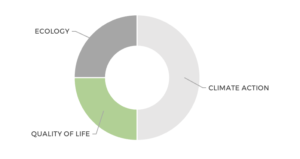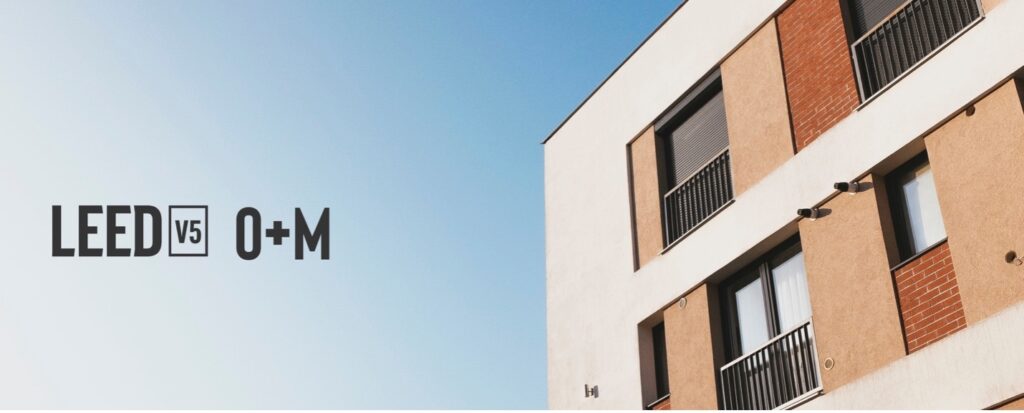The landscape of sustainable building is set to undergo a significant transformation with the advent of LEED v5, introduced by the U.S. Green Building Council (USGBC) at Greenbuild 2023. This latest iteration represents a radical structural overhaul of all LEED rating systems. Let’s take a closer look at what is new.
General Changes in LEED v5
LEED v5 ushers in a new era of building sustainability, focusing intently on setting existing buildings on a decisive path to decarbonization. It aligns with the ambitious definition of zero-emissions building, encompassing stringent requirements for LEED Zero Carbon and Platinum-level projects. This alignment aims to significantly reduce operational GHG emissions, a critical step toward achieving the goals outlined in the Paris Climate Agreement.
 At the heart of LEED v5 lies a strategic blend of priorities: half of the rating system is devoted to climate action, including decarbonization and resilience. Quality of life, encompassing social equity, health, well-being, and indoor air quality, accounts for a quarter. The remaining quarter focuses on ecology, extending beyond site and landscape to include considerations like ecotoxicity and material-related pollution. This philosophy ensures that principles such as decarbonization, resilience, health, equity, and ecosystems are interwoven into the fabric of the rating system.
At the heart of LEED v5 lies a strategic blend of priorities: half of the rating system is devoted to climate action, including decarbonization and resilience. Quality of life, encompassing social equity, health, well-being, and indoor air quality, accounts for a quarter. The remaining quarter focuses on ecology, extending beyond site and landscape to include considerations like ecotoxicity and material-related pollution. This philosophy ensures that principles such as decarbonization, resilience, health, equity, and ecosystems are interwoven into the fabric of the rating system.
The updated LEED v5 now promotes such important aspects as equity, health, ecosystems, and resilience. This broadened perspective reflects a holistic approach to creating built environments that are not only environmentally responsible but also equitable, healthy, and resilient. This integration reflects a shift from viewing sustainability categories as isolated to understanding them as interconnected components of a larger ecological and social system.
A key aspect of LEED v5 is its focus on addressing all significant sources of carbon emissions in buildings, providing clear steps to achieve ultra-low greenhouse gas emissions. The system rewards existing buildings for their leadership in planning and implementing future decarbonization targets.
Updates in LEED v5 for Operations and Maintenance (O+M)
Optimizing existing buildings’ operations is pivotal for sustainable building management, as well as the highest priority. It’s not just about reducing carbon footprints; it encompasses a broader spectrum of social and environmental responsibilities.
Innovation and Flexibility
One of the most notable structural changes in LEED v5 is the introduction of a credit category called “Project Priorities and Innovation.” This category is set to influence future rating systems and offers project teams a range of subcategories to choose from. These include “Innovative Strategies,” a flexible, free-form option allowing for creative approaches to sustainability. In the O+M version of LEED v5, the innovation subcategories include:
- Regional and Local Priorities
- Project Type Priorities
- Exemplary Focus
- Pilot Credits
- Innovative Strategies
These subcategories allow for a tailored approach to sustainability, recognizing the unique needs and contexts of different projects and regions. The shift in this category reflects a move away from the overly prescriptive nature of past versions. The goal is to enhance flexibility and adaptability in how projects can earn points, with a diverse “point library” offering between 10 to 20 points for various innovative actions.
Essential Prerequisites and Credits
At the forefront of the LEED v5 draft are three foundational prerequisites that cut across different sustainability categories, laying the groundwork for a comprehensive approach to building assessment.
- Assessment for Climate Resilience
- Social Impact Assessment
- Operational Carbon Projection
The Operational Carbon Projection in LEED v5 represents a significant advancement, requiring buildings to estimate their carbon emissions under typical operating scenarios. This prerequisite enables teams to evaluate the evolving energy landscape, especially the transition from fossil fuels to renewables, and to pinpoint sustainability goals for 2050. This focus on direct greenhouse gas emissions marks a shift towards a deeper understanding of a building’s environmental impact, broadening the scope of carbon literacy in the building sector.
Following these assessments, LEED v5 offers teams the opportunity to earn credits for planning and taking proactive steps in two key areas:
- Operational Planning and Response for Resilience
- Equity within Operations and Maintenance Staff
Structural and Process-Related Changes
The shift towards using the Arc platform in LEED v4.1, while a significant step, was offering a limited view, capturing only a momentary snapshot of building performance rather than fostering a continual path of improvement. In response, LEED v5 introduces a revamped structure for prerequisites and credits, categorizing them into three sequential stages: planning, acting, and performing. This new framework, while bearing resemblance to the previous O+M structure that emphasized policy development with more flexible performance criteria, is now designed to weave the concept of continuous improvement throughout the certification process.
The clarity and direction provided by this updated structure are crucial. It goes beyond merely listing requirements, offering a roadmap for effective implementation. The goal is to promote realistic planning that sets projects on a course for enduring success. This evolution in the LEED v5 framework signifies a move from just planning to actual, sustained enhancements in building performance.
Revised Energy Performance Standards
In a significant shift from previous standards, LEED v5 introduces a new, more inclusive energy performance threshold. Unlike LEED v4, which mandated an Energy Star score of 75, LEED v5 sets this threshold at a more accessible Energy Star score of 60. This change aims to broaden the scope for buildings striving for sustainability, aligning with the evolving needs of the real estate sector.
This adjustment in energy performance criteria comes with a critical nuance: while the entry threshold is lowered, buildings can only start accumulating energy points towards certification once they achieve an Energy Star score of 69. This approach balances the need for inclusivity with the ambition to drive improvements in energy performance.
Increased Transparency in Operations and Performance Metrics
LEED v5 O+M emphasizes greater transparency in how buildings report and manage their sustainability performance. This update addresses the need for clear, understandable metrics and benchmarks, making it easier for facility managers and stakeholders to track progress and understand the scoring system.
The aim is to eliminate any ambiguity in the rating system, ensuring that all criteria, scores, and formulas are openly accessible and comprehensible. This enhancement is particularly important in the context of energy performance and environmental impact reporting, where stakeholders must be able to accurately measure and verify the building’s sustainability achievements.
LEED v5 represents a transformative step in the journey toward sustainable building practices. With its comprehensive approach to decarbonization, equity, health, resilience, and ecosystems, LEED v5 is aimed to set a new benchmark in the field of green building certifications. As the building industry anticipates the roll-out of LEED v5 for Building Design and Construction (BD+C) in 2024, the impact of LEED v5 on the future of green buildings is poised to be substantial and far-reaching.













